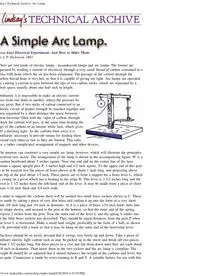
Simple Arc Lamp 1903 PDF
Preview Simple Arc Lamp 1903
Lindsay's Technical Archive: Arc Lamp http://www.lindsaybks.com/arch/arc/index.html[8/26/2010 4:55:05 PM] from Easy Electrical Experiments And How to Make Them by L P Dickinson 1903 There are two kinds of electric lamps - incandescent lamps and arc lamps. The former are operated by sending a current of electricity through a very small thread of carbon contained in a glass bulb from which the air has been exhausted. The passage of the current through the carbon thread heats it very hot, so that it is capable of giving out light. Arc lamps are operated by causing a current to pass between the tips of two carbon sticks, which are separated by a short space, usually about one-half inch in length. Ordinarily it is impossible to make an electric current pass from one body to another, unless the pressure be very great. But if two sticks of carbon connected to an electric circuit of proper strength be touched together and then separated by a short distance the space between them becomes filled with the vapor of carbon, through which the current will pass, at the same time heating the tips of the carbons to an intense white heat, which gives off a dazzling light. As the carbons burn away it is ordinarily necessary to provide means for feeding them toward each other as fast as they are burned. This calls for a rather complicated arrangement of magnets and other devices. The amateur can construct a very simple arc lamp, however, which will illustrate the principles involved very nicely. The arrangement of the lamp is shown in the accompanying figure. W is a wooden baseboard about 5 inches square. Near one end and on the center line of the base mount a square upright post P, 3 inches high and 1/2 inch square. To the upper end of this post is to be secured two flat pieces of brass shown at R, about 1 inch long, and projecting above the top of the post about 1/2 inch. These pieces are to form a support for a brass lever L, which is swung on a pivot which has a bearing in the strips R. This lever is 3 1/2 inches long and the pivot is 1 1/2 inches from the left-hand end of the lever. It may be made from a piece of sheet brass 1-16 inch thick and 1/4 inch wide. In order to support the carbons there will be needed two small brass sockets shown at C. These are made by taking a piece of very thin brass and curling it up into the form of a very short tube 3/8 inch long and 1/4 inch in diameter. At S is a piece of brass 1/16 inch thick, bent into the shape shown, and secured to the post at the bottom, so that the outer end of the spring projects 2 inches from the post. Near the outer end of the lever L and the spring S solder one of the little brass sockets just described. They should be equal distances from the post P when the lever L is horizontal. Make a small lead weight, preferably in the form of a ball, as shown at B, provided with a hook so that it may be hung on the outer end of the horizontal lever. The lever should be so nicely pivoted that it swings very freely up and down. Take a piece of ordinary electric light carbon such as may be picked up in the street and break off two pieces about 1 1/2 inches long. Put these pieces in a vise and file them down until they are each about 1/8 inch in diameter. Then insert them in the two sockets and the arc lamp is complete. The weight B should be so adjusted that it almost balances the weight of the carbons and lever, but not quite. Connection is made by wires running to R and S. A suitable battery for use with this Lindsay's Technical Archive: Arc Lamp http://www.lindsaybks.com/arch/arc/index.html[8/26/2010 4:55:05 PM] lamp will be described in the next paper. next: Laboratory Balance plans Back to Archive Index---> Lindsay Books Home Get a Catalog Place an Order Contact Us Land of Gingery Laboratory Trauma Center Archive x
